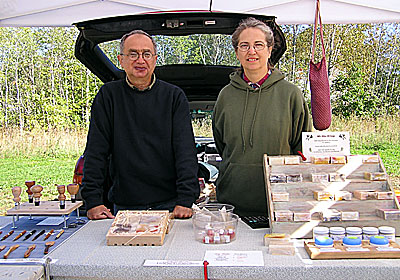 |
| Ana and Roy Antaki sell their fermented foods, as well as crafts and soaps, at the Belfast and Camden Farmers’ Markets. English photo. |
Fermented Foods & Contented Fowl
by Jean English
Nine years ago, Ana and Roy Antaki of Weeping Duck Farm in Montville moved from conventional, corporate jobs in Kansas City to a 150-acre former dairy farm in Maine. Since then they’ve moved from conventional back-to-the-land methods of feeding themselves to the newer (or older) method of preserving foods by fermentation.
Ana, with a master’s degree in business, was working for Hertz in New York City when she met Roy. After being trained in agronomy and enology (the science of winemaking) in France, Roy and his Ph.D. were employed by a trading company, which transferred him to New York. Two months later, says Roy, he and Ana “met, got married, then started dating.” And they still are, after 30 years.
From there, Roy was transferred to Kansas City, where he and Ana quickly saw what they’d heard environmentalists talking about: sprawl and the destruction of wildlife habitat. As Ana sums up the situation there: “The birds don’t have any place to go.” They decided “that maybe we should live in a way that is less noxious to the planet; a much simpler way,” says Ana.
Their four years in status-conscious Kansas City, where neighborhood rules even prohibited hanging out laundry and growing tomatoes in the back yard, “were a blessing in a sense,” Roy explains. “It made us realize that we wanted to get out of the rat race.” They sold everything (except 15 birds) and moved to Montville. “We were innocent enough that we moved in mid-January,” says Roy, arriving at their farm just ahead of a snowstorm. “We were lucky.”
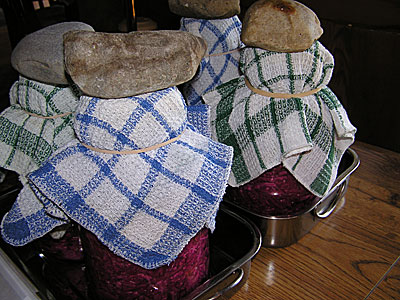 |
| Cabbage must stay submerged in order for anaerobic fermentation to take place. Small jars containing water fit just inside the tops of these large jars; cloths are for sanitation, and rocks hold the small jars down. |
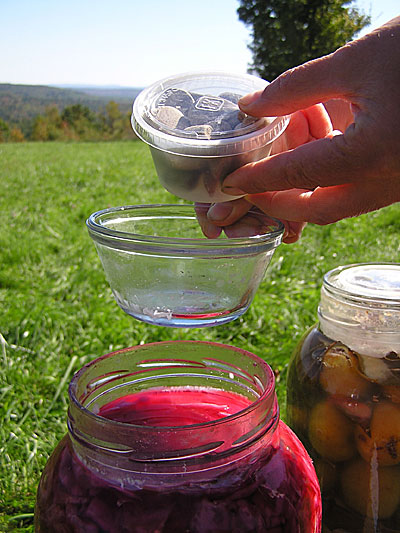 |
| Small glass bowls holding cups of stones weigh down this sauerkraut. |
They hadn’t known anybody in Maine at the time, but Ana had come to Camden on business when she was director of international sales and marketing for Hertz. “I thought that Camden was the prettiest place I had ever seen,” she says. Later she read about the Nearings and thought, “Somebody else has thought about [living with a lower impact]. So I’m not nuts!”
She and Roy had considered Washington state and Vermont as other potential sites for their version of the Nearing life. After a two-week visit to western Washington, however, they were uncomfortable with the “Microsoft yuppie” atmosphere. They ruled out Vermont because Maine’s climate seemed a little more conducive to gardening; because real estate taxes were higher there “and we knew that we were going to live on a more limited economy,” says Roy; and they found that people in Maine were “very, very nice, still very down-to-earth,” while Vermont’s tourism from Boston, New York and Montreal seemed to provide less of that flavor.
Their home on a hillside adjacent to Hogback Mountain sits on fields and woods that offer blueberries, blackberries and apples, as well as space for the Antakis’ peacocks to roam. Wild birds, too, “have lots of places to go” at Weeping Duck Farm. “It’s not so much that we found this place, but rather, this place found us,” Ana believes.
The farm name memorializes “little Zippy, a beloved pet duck who was killed defending his tiny flock when it was attacked by abandoned stray dogs.” The Antakis also memorialize Zippy’s “selfless, courageous spirit” by adopting ducks rescued by a licensed wildlife rehabilitator—some, unfortunately, crippled. At Weeping Duck, these birds live out their natural lifespan, and they’re featured on the Antakis’ Web site, www.weepingduckfarm.com, as well.
Ducks and chickens freely move from their shed to their fenced yard, which protects them from predators. These birds are pets; as vegans, the Antakis don’t eat eggs, although they do sell these products at the Belfast and Camden Farmers’ Markets.
Starting with Soap
At the Common Ground Fair, Ana saw someone making soap. “I’d never thought about soap,” she says. “It’s one of those things that you just take totally for granted, right?” The Fair soap “looked so clean … I thought, I could make soap! It looks so simple!”
She went to a workshop on soapmaking at Johnny’s Selected Seeds, then came home and made her own. “You can’t make small batches,” she explains. “Eventually you’re going to have soap for a large population.” She started selling her vegetarian product (soap made with olive oil) through stores, including the Belfast Co-op Store; then someone suggested that she sell at the farmers’ market – which she did, and “I quickly realized that you cannot make a living on soap.”
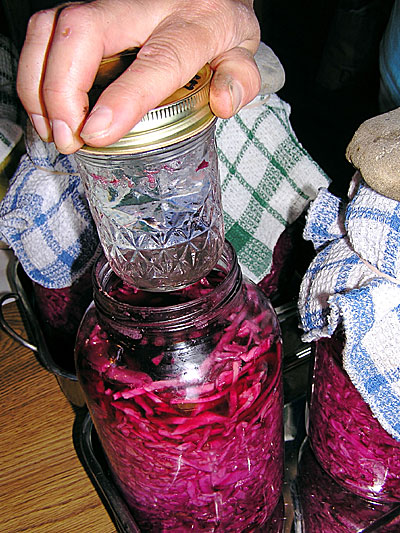 |
| Close-up of jars containing water. |
Finding Fermentation
Given Roy’s knowledge of winemaking, and the fact that he grew up “in the equivalent of the 18th century” with grandparents who still made everything from scratch and stored food without using refrigeration or canning, he and Ana unsurprisingly moved toward fermenting foods. “We went the traditional route” at first, Ana notes, “with a chest freezer, canning equipment, canning books… The first summer, we were pickling, freezing, canning,” then eating “kind of flat, limp green beans” from the freezer. Roy describes recipes they found through USDA: “Basically you kill [the food], then when it’s dead, you make sure you kill it a second time.”
“We thought, maybe there’s a better way to do it,” Ana continues. “We asked, What did people do before electricity and sophisticated canning equipment?
“Somebody mentioned lacto-fermentation,” she continues, “and I said, Milk? Then I realized it wasn’t that,” but was preservation using Lactobacillus bacteria. “Lactobacillus will transform the food and create lactic acid out of sugar,” Roy explains.
She got Keeping Food Fresh. Old World Techniques and Recipes, and Wild Fermentation, then found more recipes in ethnic cookbooks, and got some from fellow Montville farmer Sandy Spinney. “The cukes came out nice and crisp. We moved on to sauerkraut [‘Red Ace’ cabbage being their favorite for sauerkraut] and green tomatoes in brine. This year we’re trying apples in brine.” The sauerkraut was a great discovery for Ana, whose “only other experience with sauerkraut was in the New York City schools … I found the stuff revolting! It smelled awful and had an awful appearance. I didn’t understand how people ate the stuff!”
They had already been making their own tofu, which is not a fermented product; so they decided to try tempeh, a fermented soy food – to great success.
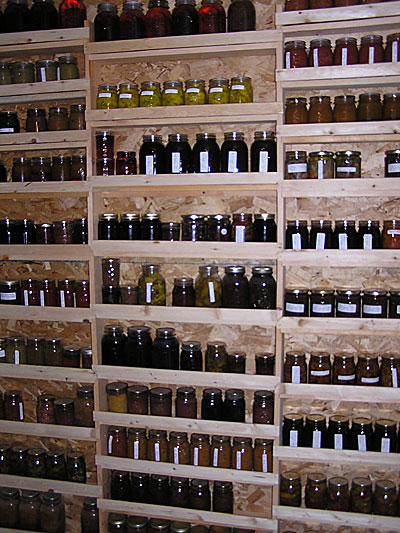 |
| A sampling of the preserved foods in the Antakis’ root cellar. |
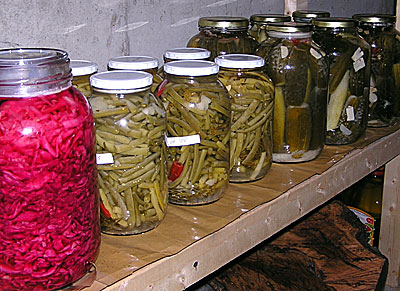 |
| Sauerkraut, beans and pickles. |
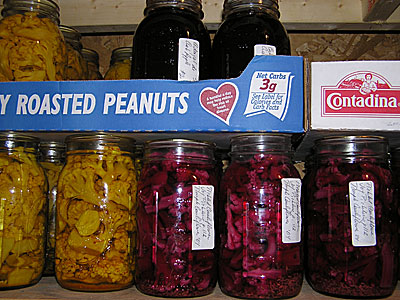 |
| Pickled-cauliflower. |
They had some fermented Japanese pickles, “which were really good, different from anything I had tasted,” says Ana. “They were pickled in miso, and I figured the only way I was going to afford to have any quantity was to learn how to make my own miso, which I did.” Now she and Roy also make lacto-fermented dilly beans, carrots, kim chee, pickled (fermented) cucumbers and tomatoes, as well as apple cider vinegar, apple cider and hard cider – which Roy puts in champagne bottles, adding a little sugar, to make cider champagne. They also make beer and wine, but, jokes Roy, “We’re sober most of the time.”
“The products came about just as our desire to find alternative ways of preserving food that don’t consume energy and are crisp,” says Ana. Roy talks about their kimchee – “real, fermented kimchee” as opposed to “overnight kimchee.” Theirs, says Roy, “contains enough of the yeast and elements that facilitate digestion that some of our customers keep buying it for their digestion.” Ana believes that this food is medicinal. “Some of my reading has convinced me that fermented foods are really superfoods. You increase the nutritional value of food when you ferment it.”
Having vegetables available all year, fresh or fermented, the Antakis rarely shop for food. “The only things we buy at the supermarket are canning jar lids!” Ana quips. They buy grains and beans in bulk at Uncle Dean’s in Waterville; and they buy bulk olive oil.
The Antakis spent some time figuring out how to keep vegetables submerged, so that the anaerobic process of fermentation will take place, and undesirable, aerobic organisms wouldn’t grow. They’ve come up with systems of glass jars and glass custard bowls or small canning jars, weighted with water or stones. (See photos.)
Sauerkraut Example
To make sauerkraut, Ana says to shred cabbage (by hand or in a food processor); gradually put 5 pounds of cabbage in a bowl, adding 3 Tbsp. sea salt in total, but adding it gradually with each layer of cabbage. Mix the salt and cabbage, then put the mixture in glass jars. Press the mixture down, using a small canning jar filled with water, if that fits snugly on your glass jar. The water will come out of the cabbage, to the point where some water will overflow the jar. Collect and save this “cabbage water” in the refrigerator, to add to the jar as the volume of solution in the jar goes down (when stored in a cool root cellar). The cabbage should not be above the water at any time.
Making pickled green beans is similar, although the beans don’t contain much water, so a brine solution of 2 Tbsp. of sea salt per quart of water is made to cover them (along with garlic and dill).
“The thing you cannot deviate from,” Ana emphasizes, “is the salt-to-water ratio. The salt is very protective. It encourages selective, beneficial bacteria to grow. And the other rule is to keep all vegetables completely submerged in the brine at all times.”
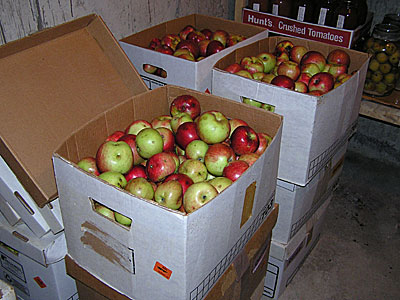 |
| The best filing system! Ana and Roy collect apples and store them in their root cellar in file boxes that they had on hand. The apples are used to make cider and vinegar. |
To make miso, they steam rice or barley, then inoculate it with a specific culture that they buy from G.E.M. Cultures (30301 Sherwood Road, Fort Bragg, CA 95437; www.gemcultures.com). After 36 to 48 hours (depending on the ambient temperature), this is mixed with cooked soybeans, salt and liquid; mashed; and stored. The storage time determines the type of miso made. A three-month miso will be light or sweet; less salt is used with this type, since it’s not expected to last so long. Other misos are six-month, nine-month, one-, two- or three-year products. The Antakis wait at least six months before using theirs. Currently they make large batches in 5-gallon food-grade plastic buckets, but they’re acquiring 5-, 10- and 20-liter glass containers (made by Libbey in Mexico and available from Instawares at www.instawares.com/libbey-glassware; from www.restockit.com; from www.specialtybottle.com; or from www.amazon.com – search under ‘glass storage jars’) and shifting away from plastic. Ana also got several half-gallon glass jars, salvaged by a friend who worked at Dairy Queen. She suggests checking redemption centers for glass jars, too. They’ve found that pottery crocks are prohibitively expensive ($110 for a 2-1/2-gallon crock, without shipping).
To make kimchee, they let processed (cleaned and cut) vegetables sit overnight in brine, remove and drain the vegetables, then mix them with seasonings and add back enough brine to completely cover the vegetables.
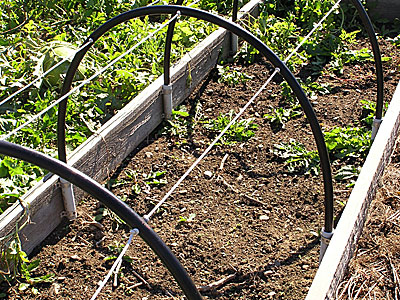 |
| Garden beds can be covered with plastic or row covers by spreading the material over these hoops. |
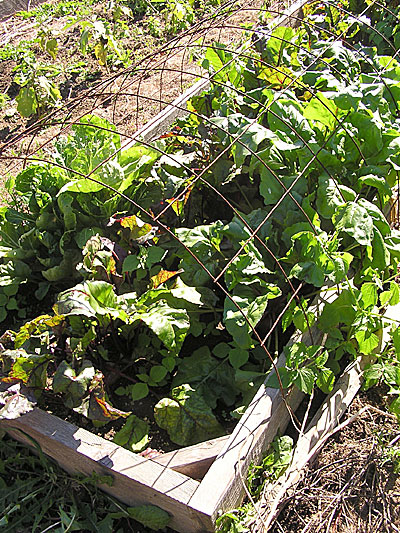 |
| A garden bed is covered with reinforcing wire to protect greens from deer. |
They don’t advise lacto-fermenting beets, which turn black – although “turshi” (lacto-fermented turnips) may have one beet added, for a pale, pinkish color. They have made sauerruben when they had a lot of rutabaga and carrots in the garden.
A Typical Supper
Given all of the stored vegetables the Antakis have on hand, what is a typical supper like? Roy says that it usually consists of a starch (brown rice, potatoes or whole grain pasta), a bean (tempeh or tofu, for example), a vegetable (broccoli, cauliflower, carrots, etc., fresh during the growing season; and some from the root cellar during the winter); and a “salad” of fermented foods. Pickled Japanese radishes “are very nice over rice at the end of the meal, almost like dessert,” says Roy. “You could say that we live on a wide range of complex, whole carbohydrates and plant-based foods.”
Preserving Knowledge
The Antakis are satisfied with their move from corporate life to their Montville farm. “Money isn’t everything,” says Roy. “Money is actually a hindrance. When you try to make money just for the sake of making money, you always want more.” He says he’s come full circle from his youth with his mother and grandmother’s preserved foods. He also realizes, however, that with the shift in energy availability, “we need to preserve that knowledge” of low-tech food storage, “because it’s going to be useful again.” Likewise they’re collecting and preserving glass bottles, which aren’t made so much any more.
They may also be preserving health. Roy says he was born a vegetarian: “When I was a kid, I didn’t want to eat meat.” Ana became a vegetarian after learning about inhumane treatment of animals in some conventional operations. “I thought that in the twentieth and twenty-first century, we were more evolved and didn’t do all those horrible things; well, actually we’re much worse, on a much bigger scale.”
Now she believes that the diet she and Roy follow is healthful as well as humane, as do some of their farmers’ market customers who have had cancer or other diseases. Roy says that lactofermented foods haven’t been proven to be good for those with cancer, but evidence suggests that they are.
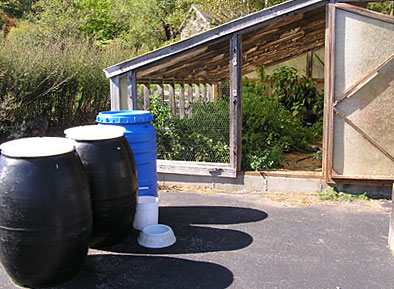 |
| Tomatoes and peppers are grown in this sun-heated greenhouse. |
Ana is interested in the relationship between protein intake and cancer, and believes that their low-protein diet is healthful. She mentions work by Colin Campbell, Ph.D., who found that children in the Philippines who had more animal protein in their diets (children from affluent homes) had a higher incidence of liver cancer than poorer children who ate less protein. Campbell then found a study of rats that were injected with cancer-causing aflatoxin. One group was fed a 5% protein diet; the other, 20 percent. The latter got cancer; the former didn’t. When the study was duplicated, so were the results. When rats were switched from a 20% to a 5% protein diet, their tumors shrank; when switched back to 20%, rats’ tumors started growing again. Campbell then conducted “The China Study” by observing a very large, fairly homogenous human population in rural China and found the same results.
The Antakis don’t know whether organic animal protein, as promoted by the Weston A. Price Association (westonaprice.org), would give the same results. They do think that “the most important thing is to have a functional digestive system. That seems to be the gateway [to health]; it seems so simplistic.” Roy adds that “fermentation is basically what you could call predigestion.”
Business Grows
Their customers seem to agree, as the Antakis’ ever-present booth at the Camden and Belfast Farmers’ Markets attest. They sell dips and spreads, such as different varieties of hummus; fermented foods, such as kimchee, tempeh and miso; veggieburgers; as well as woodcrafts that Roy makes – and, of course, Ana’s soaps. They’ve been surprised to find that “the tempeh really sells.” Many of their products (but not the food items) are also available on their Web site.
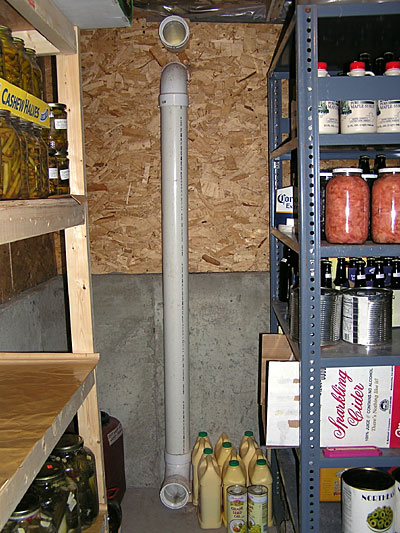 |
| Cool air comes into the root cellar through the bottom pipe, while warm air exits through the top pipe. |
Garden Varieties and Techniques
Weeping Duck Farm’s gardens are not extensive but are very productive. A fascinating find this year was ‘Ali Baba’ watermelon from Baker Creek Heirloom Seeds (a source of seed of open-pollinated varieties). Originally from Iraq, the variety would be late, thought the Antakis, but it was the earliest melon in their garden – “and it’s delicious,” says Roy.
They grow tomatoes in cages made from reinforced concrete wire. In the spring, or when the weather gets cool, they surround just the bottoms of the cages with plastic – “like a Wall O Water without the water,” Roy says. That’s enough to produce heat that they can feel with their hands, and to protect the plants on their windy site.
Catnip that just appeared in their garden is a permanent crop now. “It makes a wonderful tea,” says Ana.
They like ‘Red Ace’ cabbage for its color, beauty, and the fact that cabbage worms don’t bother it as much as they do green cabbages. Their ‘Tuscan’ kale will be covered to extend the picking season and to protect it from deer.
Favorite tomato varieties include ‘Jaune Flamée,’ a prolific, slightly tart variety; ‘Black Cherry,’ which is sweet and purple; ‘White Wonder,’ which “is not the prettiest, but it makes interesting sauce or salsa,” says Roy; the large ‘Paul Robeson’ tomato; and ‘Plum Lemon,’ which they like for sun drying. (Roy also likes to slice melons thinly and dehydrate them.)
Their seeds come from Fedco Seeds in Waterville, Maine; and from Baker’s Creek in Missouri. “I try to support people who are doing the things we believe in,” says Ana.
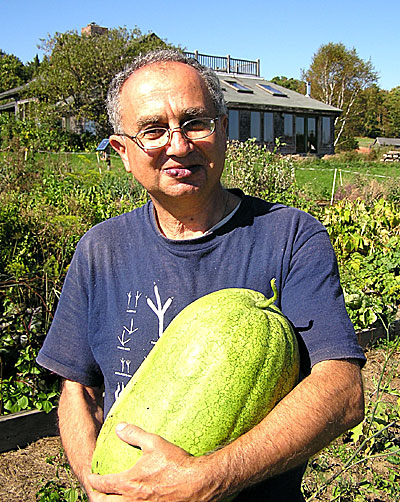 |
| Roy holds an ‘Ali Baba’ watermelon, which was the earliest-maturing watermelon at Weeping Duck Farm this year. The seed, from Baker Creek Heirloom Seeds, was collected in Iraq. |
Their watering system consists of a large barrel sitting in the garden, gravity fed from barrels at the house, which are fed by runoff from the roof. They take water out of the garden barrel by hand to irrigate plants.
Leaving a Legacy
Roy and Ana look at their beautiful property and ask, “What can we do with it? Eventually somebody has to take over this place, and we’d like to keep it wild.” So they have a long-going conversation about how to protect this piece of land that’s large enough to be kept wild … and to keep Zippy’s memorial thriving.
Resources
Baker Creek Heirloom Seeds, 2278 Baker Creek Rd., Mansfield MO 65704; www.rareseeds.com
Campbell, T. Colin, Ph.D., The China Study, Ben Bella Books, Dallas, 2005.
Fedco Seeds, PO Box 520, Waterville ME 04903; www.fedcoseeds.com
Aubert, Claude, editor, Keeping Food Fresh, Old World Techniques and Recipes, Chelsea Green, 1999.
Katz, Sandor, Wild Fermentation, Chelsea Green, 2003.
Jaffrey, Madhor, World of the East, Alfred Knopff, 1983
Ziedrich, Linda, The Joy of Pickling, Harvard Common Press, Boston, 1998.
